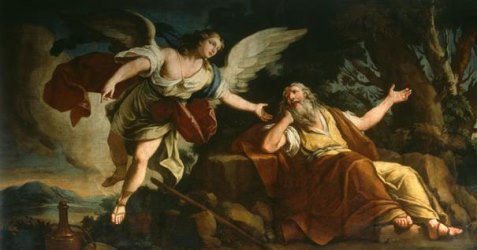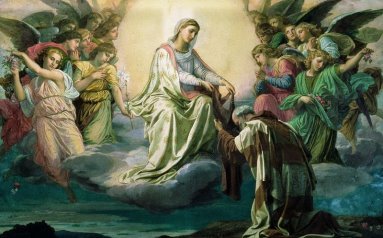The History of Carmel
"Behold I will allure her, and will lead her into the wilderness: and speak to her heart." Hosea 2:14
The story of Carmel is a story of love, of prayer and of sacrifice. It is a story of courageous men and women who respond to a call from God to seek him in silence and solitude. It is a story of people who, like the merchant in the Gospel, sell all they possess in search of the pearl of great price - hidden union with God.
Prompted by this quest for God, some holy men after the crusade settled themselves on Mount Carmel to commune with God on Mount Carmel. After the Holy Land had been reopened to the Christians during the time of crusades, a number of pilgrims and crusaders settled on Mount Carmel in the latter part of the twelfth century to live as hermits in imitation of Prophet Elijah.
They came to be known as brothers of our Lady of Mount Carmel. These Carmelite forefathers embraced a particular manner of living modeled after Blessed Virgin and Prophet Elijah. At the Request of Brocard, the prior on Mount Carmel, St. Albert, who was then the patriarch of Jerusalem, wrote the rule of life for them in the year 1209. The Rule was based on the way these brothers were living. "The hermit Brothers of Blessed Virgin Mary of Mount Carmel" as they came to be known placed themselves under the protection of our Lady and they built in her honor a beautiful Church.
During the mid - 13th century the disturbed political situation in the Holy Land forced the Carmelites to migrate to Europe. They could not follow the same simple form of life they had lived on Mount Carmel; they had to make some adaptations to the changed situation in which they found themselves. During this painful time of adjustment, God blessed the Carmelites with an extraordinary leader, St. Simon Stock. He begged our Lady to protect the order dedicated to her. In a vision he received from her the protection of the order. Soon the order took root and spread throughout Europe. Blessed John Soreth founded and supported the communities of Nuns in the order in 1452, when he was General. Due to frequent wars and plagues a general climate of decline came on all forms of religious life. The Carmelite Rule was also mitigated.
Elijah and Carmel

Elijah is considered as the Father of all Carmelites.
Elijah was the great prophet in the Northern Kingdom of Israel in the 9th century B.C during the reign of King Ahab.
Carmelites understand Contemplation as standing in the presence of God with an open heart. This is exactly what Elijah did.
'Standing in the presence of God'- What does it imply?
It is an openness of heart to be filled with His love. It made Elijah burn with zeal- "With zeal I have been zealous for the Lord, the God of Hosts" 1 King 19:20
Elijah stands for passionate love of God and a Carmelite is called to be all aflame with the "sword of the Spirit the Word of God" (Rule of Carmel)
The love of God was within Elijah an ever consuming fire. He was a passionate lover of Yahweh who did everything at the Lord's command. After delivering the oracle at the at the court of Ahab he hides himself beside the brook of Cherith and then move on to zarepath to the house of a poor widow. Dramatic events that follow are depicted in the brief account on Elijah which appear in 1 Kings Chapters 17 - 19.
Elijah evolves as a shining example of opening oneself up to the finest possibilities in the hands of a living and life giving God. The God of Elijah is not someone up above. God is someone who talks to him, feed him, scold him, walk with him, put him to sleep, wake him up and finally carry on his bosom and fly away to the fatherland.
It was the figure of Elijah that had attracted those first hermits to Mount Carmel. It is through the life of this great prophet who lived there in the presence of God, witnessing the living God, that the Carmelites became aware of their prophetic vocation. The prophetic vocation means, primarily living in the presence of God and bearing witness to Him. Elijah inspires Carmelites to look at God’s face and live each day with courage and determination.
Mary and Carmel

"Mary best exemplifies contemplative life in the Church" – Lumen Gentium
"I have found favor with this sovereign Virgin in everything I have asked of her, in the end she has drawn me to herself". Life 1:7
History of the Order overflows with the presence of the Virgin Mary. It began on Mount Carmel where the first hermits dedicated to her a little Chapel.
"The presence of Mary pervades the entire Carmelite vocation. It imparts a special Marian tone to their contemplation, sisterhood, evangelical self denial and apostolic spirit" (Constitutions Art. 53)
Mary fosters in them an attitude of Spouse, made up of receptivity and attentiveness, courage and self giving and the attitude of a mother, who suffers, intercedes, gives birth, in sorrow and joy - attitudes that were hers in Bethlehem, and her hidden life in Nazareth at the foot of the cross and in the infant Church.
Teresian Reform
In 1562, St. Teresa of Jesus, desiring to help the Church through a life of prayer and penance strove to bring about a renewal among the Carmelite Nuns.
She understood that a passionate love and joyful penance is what leads to the transformation of the heart which is the result of a life lived in seclusion. She restored the "spiritual desert" of silence, solitude, poverty and prayer of the earlier Carmelite tradition. "We are of the race of those holy fathers of Mount Carmel" She would tell her daughters.
With the help of St. John of the Cross she brought about a similar renewal among the Carmelite friars. When St. Teresa died in 1582 there were 17 convents of nuns and 15 of friars. St. Teresa gave a powerful apostolic impetus to Contemplative life.
Carmel Today
Today there are more than 900 Cloistered Monasteries of Nuns and 11951 member Nuns spread over the world of which 36 of them are in India. In Kerala we have 8 Cloistered Carmelite Monasteries of Nuns.
Carmels in India
| Sl No |
Place |
Established Year |
| 1 |
Pondicherry |
1859 |
| 2 |
Mangalore |
1870 |
| 3 |
Bangalore |
1931 |
| 4 |
Kottayam |
1933 |
| 5 |
Kolkotta |
1935 |
| 6 |
Kumbakonam |
1936 |
| 7 |
Shembaganur |
1944 |
| 8 |
Coimbatore |
1944 |
| 9 |
Thiruvalla |
1946 |
| 10 |
Goa Chicalim |
1947 |
| 11 |
Tiruchirapalli |
1956 |
| 12 |
Mumbai |
1961 |
| 13 |
Thanjavur |
1962 |
| 14 |
Kottiyam |
1964 |
| 15 |
Yercaud |
1967 |
| 16 |
Soso |
1971 |
| 17 |
Kurnool |
1974 |
| 18 |
Pune |
1979 |
| 19 |
Jalpaiguri |
1979 |
| 20 |
Sitagarha |
1979 |
| 21 |
Vijayavada |
1981 |
| 22 |
Eramalloor |
1982 |
| 23 |
Baroda |
1983 |
| 24 |
Mysore |
1985 |
| 25 |
Raipur |
1986 |
| 26 |
Patna |
1986 |
| 27 |
Hasan |
1988 |
| 28 |
Chatrapur |
1988 |
| 29 |
Chennai |
1988 |
| 30 |
Delhi |
1990 |
| 31 |
Sivagangai |
1995 |
| 32 |
Trivandrum |
2005 |
| 33 |
Malayatoor |
2008 |
| 34 |
Tutuicorin |
2014 |
| 35 |
Kannur |
2018 |
| 36 |
Thamarachery |
2019 |
Carmels in Kerala
A community of cloistered Carmelite Nuns was established in Kerala in 1933 at Kottayam through the intervention of bishop Bonaventura Arana OCD the then Bishop of Kottayam from Cerro de los Angeles – Spain.
In 1948 Kottayam Carmel had its first foundation in the Arch diocese of Thiruvalla through the instrumentality of Fr. Gheevargese OIC.
It was when Rt. Rev. Dr. Jerome Fernandez was the Bishop of Kollam in 1966 the Cloister Carmel was established at Kottiyam from the Carmel of Kottayam.
To pray for the Diocese and Priests, Rt. Rev. Dr. Joseph Kurithara Bishop of Cochin invited Thiruvalla Carmel in 1982 to establish a Cloister at Eramalloor.
In 2005 yet another new cloister Carmel was born in the capital city of Kerala – founded by Kottiyam Carmel.
It was a long cherished dream of late Cardinal Varkey Vithayathil to have a Cloistered Carmel in the Syro – Malabar Rite. It became a reality in 2008 when a Carmel was established in Malayatoor with Sisters coming from different Carmels.
Avilaaram Cloistered Carmel in the Diocese of Kannur is the daughter foundation of Thiruvalla Carmel and was inaugurated in the year 2018.
Malayatoor Carmel has the joy of seeing a daughter foundation in the Diocese of Thamaracherry which is under construction.


